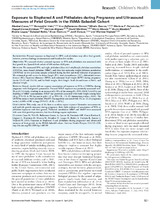Exposure to Bisphenol A and Phthalates during Pregnancy and Ultrasound Measures of Fetal Growth in the INMA-Sabadell Cohort
Autor
Casas, Maribel
Valvi, Damaskini
Gascón, Mireia
Fernández, Mariana F.
García-Esteban, Raquel
Íñiguez, Carmen
Martínez, David
Murcia, Mario
Monfort, Nuria
Luque, Noelia
Ventura, Rosa
Sunyer, Jordi
Vrijheid, Martine
Rubio Bravo, Soledad
Ballesteros-Gómez, A.
Editor
National Institute of Environmental Health Sciences (NIEHS)Fecha
2016Materia
Bisphenol APhthalates
Pregnancy
Prenatal exposure
Fetal growth
INMA study
Sabadell (Barcelona, Spain)
METS:
Mostrar el registro METSPREMIS:
Mostrar el registro PREMISMetadatos
Mostrar el registro completo del ítemResumen
Background: Prenatal exposure to bisphenol A (BPA) and phthalates may affect fetal growth;
however, previous findings are inconsistent and based on few studies.
Objectives: We assessed whether prenatal exposure to BPA and phthalates was associated with
fetal growth in a Spanish birth cohort of 488 mother–child pairs.
Methods: We measured BPA and eight phthalates [four di(2-ethylhexyl) phthalate metabolites
(DEHPm), mono-benzyl phthalate (MBzP), and three low-molecular-weight phthalate metabolites
(LMWPm)] in two spot-urine samples collected during the first and third trimester of pregnancy.
We estimated growth curves for femur length (FL), head circumference (HC), abdominal circumference
(AC), biparietal diameter (BPD), and estimated fetal weight (EFW) during pregnancy
(weeks 12–20 and 20–34), and for birth weight, birth length, head circumference at birth, and
placental weight.
Results: Overall, results did not support associations of exposure to BPA or DEHPm during
pregnancy with fetal growth parameters. Prenatal MBzP exposure was positively associated with
FL at 20–34 weeks, resulting in an increase of 3.70% of the average FL (95% CI: 0.75, 6.63%) per
doubling of MBzP concentration. MBzP was positively associated with birth weight among boys
(48 g; 95% CI: 6, 90) but not in girls (–27 g; 95% CI: –79, 25) (interaction p-value = 0.04). The
LMWPm mono-n-butyl phthalate (MnBP) was negatively associated with HC at 12–20 pregnancy
weeks [–4.88% of HC average (95% CI: –8.36, –1.36%)].
Conclusions: This study, one of the first to combine repeat exposure biomarker measurements
and multiple growth measures during pregnancy, finds little evidence of associations of BPA or
phthalate exposures with fetal growth. Phthalate metabolites MBzP and MnBP were associated
with some fetal growth parameters, but these findings require replication.

